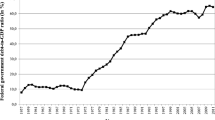Abstract
In this paper we test whether German public debt has been sustainable by testing how the primary surplus to GDP ratio reacts to the debt to GDP ratio. We apply semi-parametric regressions with time depending coefficients. This test shows that the mean of the coefficient relevant for sustainability is significantly positive over the time period considered. However, there is a negative trend in that coefficient which seems to have ceased to decline only in the middle to late 1990s.
Similar content being viewed by others
References
Abel AB, Mankiw GN, Summers NLH, Zeckhauser RJ (1989) Assessing dynamic efficiency: theory and evidence. Rev Econ Stud 56:1–19
Blanchard OJ, Fischer S (1989) Lectures on macroeconomics. The MIT Press, Cambridge, Massachusetts
Bohn H (1995) The sustainability of budget deficits in a stochastic economy. J Money Credit Banking 27(1):257–271
Bohn H (1998) The behavior of U.S. public debt and deficits. Quart J Econ 113:949–963
Diamond PA (1965) National debt in a neo-classical growth model. Am Econ Rev 55:1126–1150
Greiner A, Semmler W (1999) An inquiry into the sustainability of German fiscal policy: some time series tests. Public Financ Rev 27:221–237
Greiner A, Köller U, Semmler W (2004) Debt sustainability in the European Monetary Union: theory and empirical evidence for selected countries. CEM Working Paper, No. 71, Bielefeld University
Grüne L, Semmler W, Sieveking M (2004) Creditworthiness and thresholds in a credit market model with multiple equilibria. Econ Theor 25(2):287–315
Hamilton JD, Flavin M (1986) On the limitations of government borrowing: a framework for empirical testing. Am Econ Rev 76:808–819
Hasti TJ, Tibshirani RJ (1990) Generalized additive models. Chapman and Hall, London
Kremers JM (1988) US federal indebtedness and the conduct of fiscal policy. J Monetary Econ 23:219–238
McCallum BT (1984) Are bond-financed deficits inflationary? A Ricardian analysis. J Political Econ 92(1):123–135
Ryan TP (1997) Modern regression methods. J. Wiley & Sons, New York
Sidrauski M (1967) Rational choice and patterns of growth in a monetary economy. Am Econ Rev, Papers and Proceedings 57:534–544
Trehan B, Walsh CE (1991) Testing intertemporal budget constraints: theory and applications to US Federal budget and current account deficits. J Money Credit Banking 23:206–223
Wilcox DW (1989) The sustainability of government deficits: implications of the present-value borrowing constraint. J Money Credit Banking 21:291–306
Wood SN (2001) mgcv: GAM’s and generalized ridge regression for R. R News 1(2):20–25
Author information
Authors and Affiliations
Corresponding author
Appendix: data
Appendix: data
Source: OECD Economic Outlook Statistics and Projections.
We use the Data Set corresponding to those published in the June 2003 issue of the OECD Economic Outlook, particularly the entire data set for the Government Account and the series for Gross Domestic Product at Market Prices (GDP).
Rights and permissions
About this article
Cite this article
Greiner, A., Koeller, U. & Semmler, W. Testing the sustainability of German fiscal policy: evidence for the period 1960–2003. Empirica 33, 127–140 (2006). https://doi.org/10.1007/s10663-006-9011-2
Published:
Issue Date:
DOI: https://doi.org/10.1007/s10663-006-9011-2




